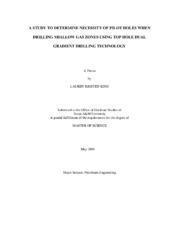| dc.contributor.advisor | Schubert, Jerome | |
| dc.creator | King, Lauren | |
| dc.date.accessioned | 2010-01-16T00:08:22Z | |
| dc.date.available | 2010-01-16T00:08:22Z | |
| dc.date.created | 2009-05 | |
| dc.date.issued | 2010-01-16 | |
| dc.identifier.uri | https://hdl.handle.net/1969.1/ETD-TAMU-2009-05-591 | |
| dc.description.abstract | When drilling offshore, shallow gas hazards are a major concern because of their
potential to cause a major blowout. This is a special concern when drilling in shallower
water, where the gas influx reaches the rig sooner. A common practice used to avoid the
potential dangers of shallow gas is to drill a pilot hole through the shallow gas zone with
the hope that the smaller diameter hole will prevent such a large influx. The use of dual-gradient
top hole drilling technology would allow for a larger hole to be drilled and the
possible gas influx to be killed dynamically, which I have simulated with the use of a
top hole dual-gradient simulator. | en |
| dc.format.mimetype | application/pdf | |
| dc.language.iso | en_US | |
| dc.subject | Dual gradient drilling | en |
| dc.subject | top hole drilling | en |
| dc.title | A Study To Determine Necessity of Pilot Holes When Drilling Shallow Gas Zones Using Top Hole Dual Gradient Drilling Technology | en |
| dc.type | Book | en |
| dc.type | Thesis | en |
| thesis.degree.department | Petroleum Engineering | en |
| thesis.degree.discipline | Petroleum Engineering | en |
| thesis.degree.grantor | Texas A&M University | en |
| thesis.degree.name | Master of Science | en |
| thesis.degree.level | Masters | en |
| dc.contributor.committeeMember | Juvkam-Wold, Hans | |
| dc.contributor.committeeMember | Suh, Steve | |
| dc.type.genre | Electronic Thesis | en |


